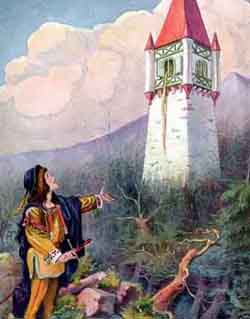On the trail of a fairytale world in south-western Germany
 Tuebingen, Germany - Feel like escaping to the world of Grimm's fairytales with gigantic castles, dark forests and medieval villages? Then the Zollernalb region in south-western Germany might be just the place to visit.
Tuebingen, Germany - Feel like escaping to the world of Grimm's fairytales with gigantic castles, dark forests and medieval villages? Then the Zollernalb region in south-western Germany might be just the place to visit.
Situated between the south-western German city of Stuttgart and Lake Constance, the Zollernalb region offers some of Germany's most spectacular landscapes, shaped by the erosive forces of the changing warm and glacial epochs 70 million years ago.
Starting from the university town of Tuebingen a well-signposted cycle and hiking trail takes the adventurous traveller through medieval villages, past the towering Hohenzollern castle and through the Danube valley down to Lake Constance along the Swiss border.
The 195 kilometre route from Tuebingen to Constance forms part of the Hohenzollern hiking trail and is also part of the German section of St James Way - the medieval pilgrimage path that leads all the way to Santiago de Compostela in Spain.
Tuebingen is only a short train drive from Stuttgart which is linked to the high-speed train network with France, Austria and Switzerland only about a two-hour trip away.
The 15 kilometre walk on the cycle path from Tuebingen to the town of Rottenburg is a good easy walk to get the body exercised for the more strenuous paths lying ahead.
Most hotels in the region offer facilities for bicycle travellers and hikers with prices starting at about 36 to 40 euros (51 to 57 dollars) for a single room with breakfast.
After a good night's rest in Rottenburg's Hotel Anker the next day's march of 20 kilometres demands a steeper climb on mountain trails and parts of the Black Forest to Hechingen which dates back to the year 1255 when the village was established below the Hohenzollern castle. The gigantic complex dominates the landscape as it is positioned on one of the most scenic mountains in the Alb region.
Count Eitelfriedrich I (1576-1605) turned Hechingen into a centre of the arts and Renaissance architecture with many buildings from this era still intact including the monastery church St Luzen.
The Hohenzollern castle houses treasures such as the Prussian Crown and numerous artefacts from King Frederick II of Prussia. It was home to the Hohenzollern royalty that ruled Prussia and Brandenburg from the Middle Ages to the end of World War I.
Next stop is Balingen, which is entered along a beautiful footpath meandering alongside the banks of the Eyach river. A focal point in the market square is the late Gothic church built in the years between 1443 and 1541 with the 61-metre-high tower.
Another steep climb takes the hiker up the Lochenhoernle mountain with more breathtaking views of the countryside with its picture-book villages interspersed with forest and lush-green pastures. Here the traveller passes through the little village of Tieringen nestled in the mountainside at an altitude of some 800-900 metres. From here short day trips can also be taken to the nearby Danube valley.
Really worth a visit however is the village of Beuron overlooking the Danube valley with its baroque monastery that is entered crossing a medieval timber bridge. The foundations of the monastery go back more than a thousand years. Today the Beuron Archabbey is run by a community of Benedictine monks and houses the largest monastic library in Germany.
The walk then takes the hiker through dense forest that passes the Lourdes grotto in the Liebfrauental and the Bronnen castle built on a magnificent clifftop overlooking the valley. Passing through the villages of Messkirch, Wald, Stockach and Markelfingen the hiker reaches Constance after a good ten days of walking. The cyclist can do the trip in about two to three days.
The city of Constance is situated along the western end of the lake of the same name. It is a huge 538 square kilometre water basin shared by Germany, Austria and Switzerland. Constance is a vibrant contrast to the tranquil Hohenzollern countryside that could well have been the inspiration of many a Grimm fairytale and leaves the traveller with unforgetful impressions of a bygone age. (dpa)